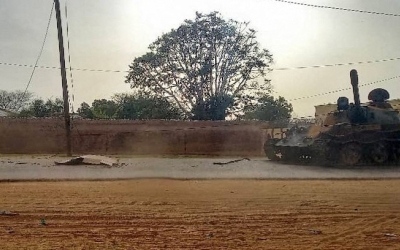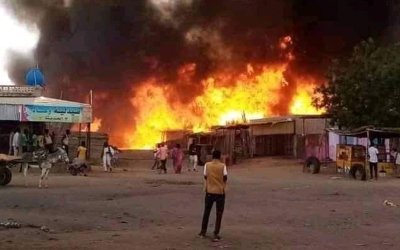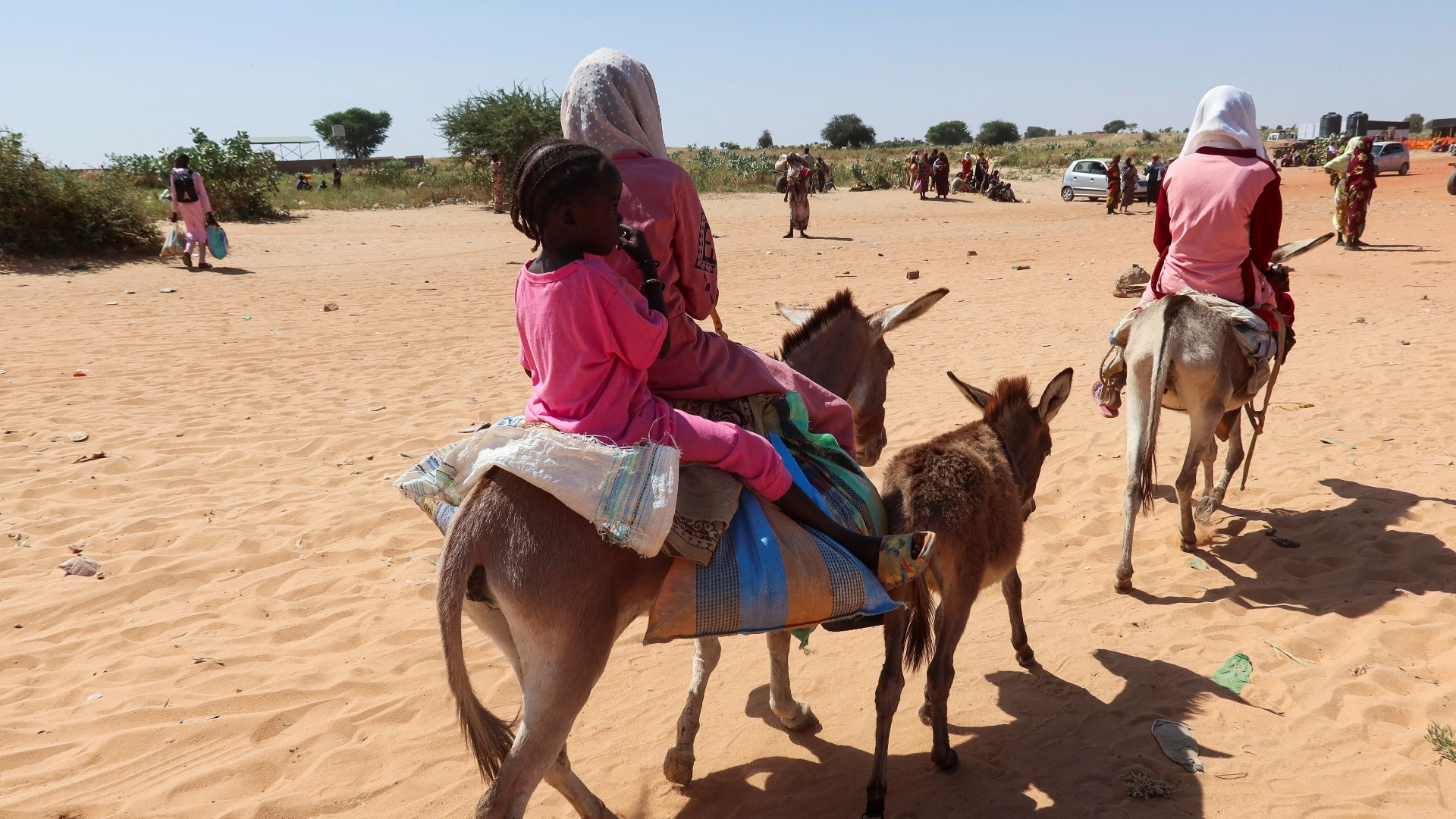[ad_1]
Around 1,300 people, mostly civilians belonging to the Massalit tribe, were slaughtered in Sudan’s West Darfur over three days earlier this month by the Rapid Support Forces (RSF) and its allied Arab militias, witnesses, local activists and human rights defenders have told Middle East Eye.
The massacres in Ardamata, an area on the northeast outskirts of West Darfur’s state capital el-Geneina, were committed after the RSF, a paramilitary force, expelled Sudanese soldiers from a military base in the suburb during battles from 2 to 6 November.
For the second time in a matter of months, the streets of el-Geneina and its surroundings have been left filled with corpses.
Witnesses said the scenes were reminiscent of June, when Arab militias and RSF fighters killed more than 500 people in what human rights organizations described as ethnic cleansing against the Massalit, a Black African tribe.
The Roots Organization for Human Rights and Violation Monitoring, a local NGO, has recorded 1,300 people killed in Ardamata since 4 November, when the RSF seized the garrison belonging to the Sudanese army’s 15th Infantry Division and then turned on the local civilian population.
Stay informed with MEE’s newsletters
Sign up to get the latest alerts, insights and analysis,
starting with Turkey Unpacked
In a new report seen by MEE, the organization said that more than 2,000 people were wounded and 500 detained as the RSF and its Arab militiamen allies brutally attacked civilians across Ardamata. Over 300 others are missing, it said.
The group said the RSF and militiamen “practiced many atrocities against the Massalit community”, including killing, raping women, looting and torching homes.
Gamal Abdullah Khamis, head of the Roots Organisation, said there are multiple indications that the death toll is above 1,300. A local media report put the death toll at 2,000, though other reports have placed the number of killed much lower.
‘We believe that the number is much higher, as other crimes and killings are being committed against civilians’
– Gamal Abdullah Khamis, activist
Khamis said the ethnic-based attacks are continuing, with Arab militias near the Chad border tracking civilians trying to flee the country and ambushing them.
“Our report is based on 700 interviews and reports we got from our monitors in Chad. We have documented the names and the details of the 1,300 people that were killed up to now,” Khamis told MEE.
“However, we believe that the number is much higher, as other crimes and killings are being committed against civilians in the areas of Kulbos, Sirba, Azorny, Adara and checkpoints on the road between Sudan and Chad.”
Middle East Eye has asked the Rapid Support Forces for comment.
Massalit targeted
Ahmed Hajar, a lawyer and human rights activist in Adre refugee camp in Chad, told MEE that he has met hundreds of families who fled West Darfur and had to leave several dead relatives in el-Geneina and its surroundings.
Hajar, who runs a human rights and social development group called al-Mawi, said his organization has registered hundreds of cases of ethnic-based killings and attacks.
After Sudan’s war broke out on 15 April between the RSF and the Sudanese military, Darfur has been the scene of some of the most ferocious fighting, alongside Khartoum.
Between 2003-2005, Darfur endured a vicious conflict, in which the government of then-president Omar al-Bashir armed thousands of Arab tribesmen, creating a militia known as the Janjaweed, which he used against Darfuri rebel groups that had revolted against Khartoum in response to longstanding neglect of the region’s Black African population.
Around 300,000 people were killed in the war, which is often described as genocidal and brought war crimes charges against several men leading it from the International Criminal Court, as the Janjaweed targeted Darfur’s Black population, driving millions from their homes.
Today, the backbone of the RSF’s paramilitary forces, including its leader, Mohammed Hamdan Dagalo, better known as Hemeti, is made up of Arab tribesmen from Darfur and its surroundings who used to be Janjaweed fighters.
According to Human Rights Watch researcher Mohamed Osman, the Massalit community, as well as other non-Arab communities, have been targeted by the RSF and its allied militias in el-Geneina since June.
“This ethnic targeting evidently can be seen in killings, especially of Massalit tribal leaders, lawyers and activists,” he told MEE, adding that camps housing 2.5 million Sudanese internally displaced by the Darfur conflict 20 years ago have also been intentionally destroyed.
“Racial slurs from attackers demanding Massalit leave the land and destroying their means of survival have all been a recurring pattern of previous attacks, and as we so far hear from the latest attacks in Ardamata.”
Atrocities follow army withdrawal
Though the RSF seized control of most of West Darfur in the war’s earliest weeks, the Sudanese military clung on in the garrison belonging to the 15th Infantry Division in Ardamata. The troops at the base were supported by irregular Massalit fighters, who previously belonged to rebel groups and held districts surrounding the garrison.
However, in recent weeks the RSF has waged a new campaign across Darfur, trying to dislodge the army from various bases it was entrenched in as the warring parties met in Jeddah for talks sponsored by the United States and Saudi Arabia.
In late October, it succeeded in expelling the army from South Darfur and Central Darfur, in a severe blow to the military.
On 4 November, the outnumbered troops in the 15th Division garrison finally capitulated to better-armed RSF fighters and Arab militiamen and fled Ardamata for Chad, escaped soldiers and witnesses told MEE.
Witnesses said the collapse led to many atrocities being committed against the Massalit in the area.
Already, around 500,000 Sudanese had taken shelter in neighbourhing Chad, mostly from West Darfur. Since the latest atrocities and RSF takeover of Ardamata, another 20,000 have fled across the border, people who recently escaped told MEE.
From Chad, witnesses told Middle East Eye by phone that they saw Arab militiamen kill hundreds of people, sexually assault women and destroy civilian houses in Ardamata.

In Sudan’s el-Geneina, the dead are left lying in the streets
Read More »
They said that hundreds of bodies were left on streets, in medical centres near the garrison and inside houses, as well as along the roads leading to the Chad border.
Mohamed Hussien, a recent refugee, said he counted nearly 200 bodies around Ardamata’s main market as fighting between Massalit former rebels and the RSF and Arab militias raged following the garrison’s collapse.
He said he saw “revenge and racist attacks on the Black African tribes”.
Ardamata resident Nasr Aldin Mohamed told MEE some of his family had been killed by RSF fighters.
“I saw fighters in RSF uniforms brutally killing soldiers after they surrendered, killing people while they shouted ‘foolish slave Massalit, we will never give you mercy. The only fate we have for you is death’,” he said.
“Three of my family, including one child, were killed in Ardamata. Others are missing and some fled to Adre with me. We didn’t even have time to bury those who were killed or look for those who went missing.”
Mohamed walked for two days to reach Chad and the refugee camp at Adre. But he said Arab militias were tracking him and his companions the whole time and killed many people in Kulbos, Adara and other areas near the border.
“Along the way I also saw dozens of bodies scattered in the streets. The militias stopped us looking for Massalit fighters and army soldiers, and killed them instantly,” he said.
Another refugee in Adre, Adam Mohamed, told MEE that three members of his family were detained by militiamen in Kulbos and he has been told to pay a ransom to release them.
“We have no way to free them unless we pay 3bn Sudanese pounds, which is around $3,000,” he said.
Footage of abuses
Ardamata consists of nine small neighbourhoods, the military garrison and a camp for people displaced by the last conflict on the suburb’s eastern side.
Residents and soldiers told Middle East Eye the RSF assault ramped up on 2 November, attacking from different directions using drones, which caused widespread damage to the army base and surrounding residential districts.
The army fought back, exchanging fire with the RSF and Arab militias until withdrawing. Then the RSF and its allies overran the base, as well as positions held by Massalit fighters supporting the army and all residential districts.
Fighting continued in Ardamata for a day after the main bulk of the army’s troops withdrew, with many civilians reportedly caught in the crossfire.
According to witnesses, hundreds of civilians had gone to the garrison hoping the soldiers would protect them.
Once the RSF took the base and the soldiers and Massalit fighters withdrew, the atrocities increased rapidly, they said.
Middle East Eye has reviewed video footage purportedly showing dozens of civilians gathered by militiamen and lashed. One of the militiamen insults the captives, saying: “Where are the weapons, where did you hide them you sons of a dog?”
Another video, apparently from Ardamata’s military hospital, shows a room full of lifeless bodies and wounded people lying on a bloody floor. Fighters are heard looking for soldiers of the Sudanese Armed Forces among them.
Another image circulating widely online shows around 16 corpses lying in a street in Ardamata.
MEE has not been able to immediately verify the footage.
International concern
The United Nations and other international organizations have condemned the attack, accusing the RSF and its allied militias of committing serious violations and promising to investigate.
The United Nations Integrated Transition Assistance Mission in Sudan said the killings indicated that the Massalit community was particularly targeted and militias rounded up people suspected of collaborating with the army.
Meanwhile, the Sovereign Council, an executive body dominated by army chief and de facto ruler of Sudan Abdel Fatteh al-Burhan, said a senior local Massalit leader was “assassinated” in el-Geneina by “RSF militias”.

Sudan: Almost all of Darfur falls to the RSF in severe blow to the army
Read More »
“The RSF’s crimes didn’t stop with the killing of the leader, but it also killed his son and eight of his grandchildren in an incident that will ignite the tribalism and hate among the people of the region,” it said in a statement.
The RSF has denied it was responsible for any massacres, earlier this week posting videos of el-Geneina that appeared to show life going on as normal, with dozens of people attending Friday prayers in the main mosque.
On the day the garrison fell, the RSF also appointed its most senior commander in West Darfur, Abdul Rahman Gumaa, as the state’s governor.
On Friday, the RSF published a video of Gumaa promising to stabilize the state and stop the activities of “outlaws” in Ardamata and el-Geneina.
He said he wanted to return services to West Darfur, echoing initiatives in South Darfur’s Nyala and Central Darfur’s Zalingi, cities that were recently seized by the RSF, which has since sought to deliver local administrative services.
Analysts previously told Middle East Eye that the RSF is seeking to set up a parallel government in Sudan, which it is doing by setting up local administrations to deliver services.
[ad_2]
Source link



